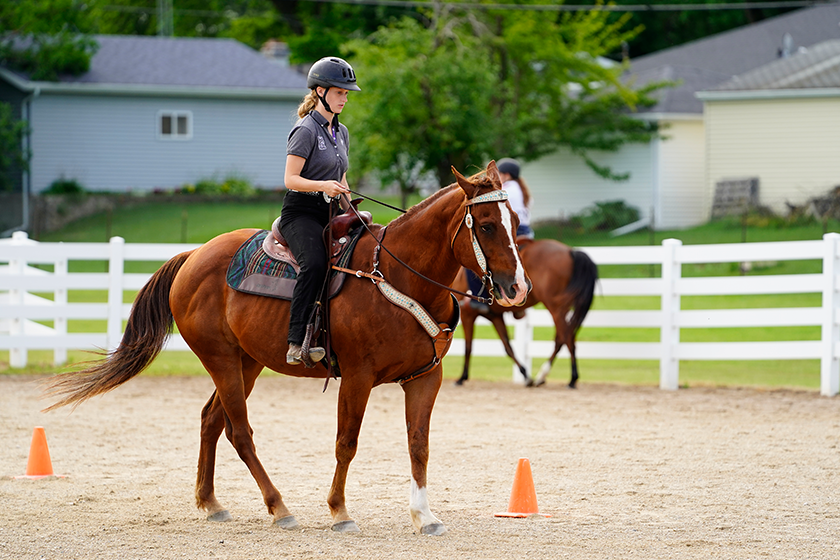

Seven Best Horse Arena Footing Options
Finding the best horse arena footing is an important consideration when you want to create a comfortable, safe, and durable riding surface for your horses. Good footing provides proper traction, shock absorption, and support, helping to enhance performance and keeping your horses safe.
This guide will explore some of the top arena footing options and the benefits of each to help you decide what will work best for your facility.
Sand Footing
Sand is one of the most popular and versatile materials used in horse arena footing. Known for its affordability, ease of maintenance, and natural traction, sand is commonly used in both indoor and outdoor arenas. Different types of sand are available, from fine to coarse grains, and the texture you choose can impact drainage, compaction, and grip.
- Advantages: Sand offers reliable traction and is relatively low-cost. It’s also easy to mix with other materials to enhance its performance.
- Considerations: Fine sand can compact too easily, creating a hard surface, while coarse sand may provide better drainage but can be abrasive. Regular maintenance, such as dragging and occasional watering, is required to keep sand consistent and dust-free.
Wood Chips or Fiber Blends
Wood chips or fiber blends mixed with sand create a cushioned surface that improves shock absorption, making it a popular choice for disciplines requiring quick turns or landings. This organic option also retains moisture well, reducing dust and keeping the arena softer underfoot. It’s common in both indoor and outdoor horse arena footing setups.
- Advantages: Provides a soft, cushioned surface that reduces impact on joints. Organic materials also help retain moisture, reducing dust in dry climates.
- Considerations: Wood fibers break down over time and need replenishing. They can also become slippery when overly wet, so adequate drainage is essential for outdoor arenas.
Rubber Mulch
Rubber mulch, typically made from recycled tires, is an effective footing option that adds cushioning and shock absorption to your arena. This material can be mixed with sand to create a well-rounded footing, combining stability with a bit of “give.” Rubber mulch also requires less frequent maintenance, as it doesn’t compact as quickly as sand alone.
- Advantages: Rubber mulch provides excellent cushioning and reduces the strain on horses’ legs and joints, particularly in high-impact disciplines. It also helps retain moisture and reduce dust.
- Considerations: Rubber can get hot in direct sunlight, making it less suitable for warm climates. It can also be an investment upfront, though it lasts longer than organic materials.
Synthetic Footing
Synthetic footings, such as geotextile fabrics or polymer-coated sands, have become increasingly popular in high-performance arenas due to their durability, low maintenance, and consistency. These engineered materials combine fibers and rubber with sand to offer a stable, dust-free, and easy-to-maintain surface.
- Advantages: Provides consistent traction and shock absorption, reducing the need for frequent watering or grooming. Synthetic materials are designed to last longer and require minimal upkeep, making them a cost-effective option over time.
- Considerations: Synthetic footings can be more expensive upfront and may not be necessary for all arenas. However, they’re an excellent choice for facilities with high levels of use or demanding performance needs.
Stone Dust
Stone dust is a durable footing option often used as a base layer or top layer in outdoor horse arena footing. It compacts well and provides solid traction, making it ideal for wetter climates where drainage is a concern. Many arena owners choose stone dust for its durability and ability to withstand harsh weather conditions.
- Advantages: Provides a solid, durable base with excellent drainage. Stone dust footing is easy to maintain and works well in both indoor and outdoor settings.
- Considerations: It can be firm and may require mixing with sand or rubber for cushioning. Stone dust also tends to create dust over time, so regular watering or dust control additives are recommended.
Sand and Rubber Mix
Combining sand with rubber mulch is a great way to create a balanced footing that offers both traction and shock absorption. The sand provides natural grip, while the rubber adds cushion, reducing impact on horses’ joints. This mix is widely used for all-around riding arenas, offering versatility for different disciplines.
- Advantages: Sand and rubber mixes combine the best of both materials, creating a durable, shock-absorbing surface with good grip. It’s ideal for facilities with diverse riding needs.
- Considerations: This mixture can be more costly than using sand alone and requires occasional maintenance, such as dragging to keep it even and prevent compacting.
Wax-Coated Footing
Wax-coated footing, often used in high-end equestrian facilities, combines sand with a wax coating to create a dust-free, low-maintenance surface. The wax coating helps retain moisture, making it ideal for indoor arenas or drier climates. This footing is popular for dressage and jumping disciplines due to its excellent traction and durability.
- Advantages: Wax-coated footing requires minimal watering and holds its shape, providing consistent performance with low maintenance.
- Considerations: Wax-coated surfaces are one of the more expensive options, but they offer long-term savings through reduced maintenance needs and extended durability.
What is the Best Horse Arena Footing?
When it comes to choosing the best horse arena footing, it ultimately depends on your specific needs, climate, and budget. Keep in mind that your choice is a long-term investment in the health and functionality of your equestrian facility. With the right footing, maintenance strategy, and equipment, you can significantly improve the quality and appeal of your arena.
Ready to upgrade your horse arena with the best footing options? Visit Greystone USA to explore our range of maintenance equipment, including innovative arena drags and groomers, pasture vacuums, and versatile travel fence systems. Equip yourself with the best tools to maintain your ideal arena footing and elevate the standard of your equestrian facility.